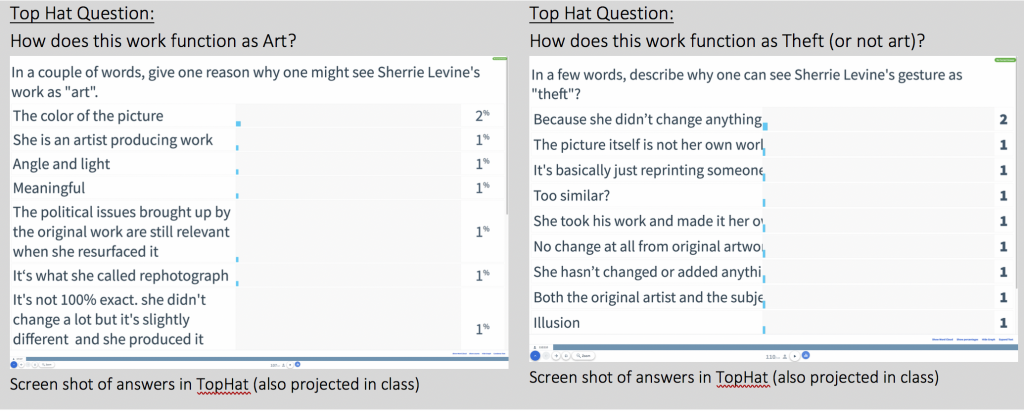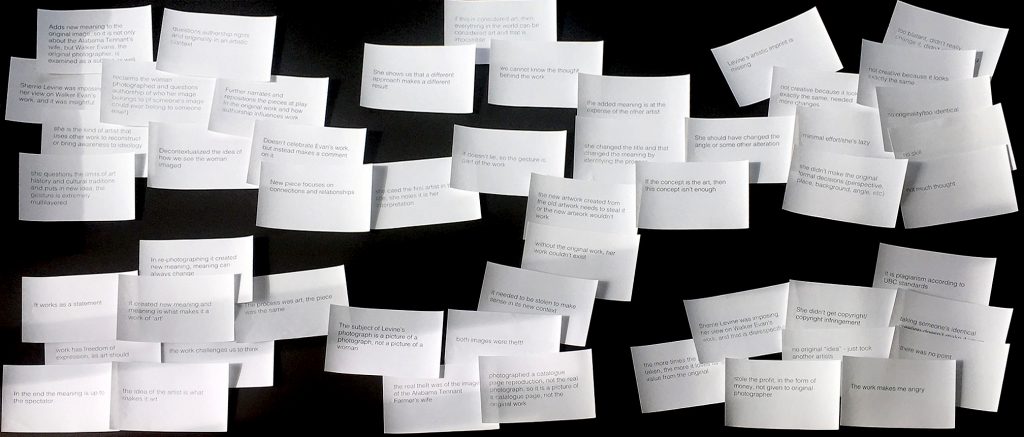February 27 – March 2 “Trickery Draft Workshop”
Outcomes
- Activate the process of making, as a way of knowing.
- Technically execute a work of digital art, and apply formal decisions that communicate ideas visually.
- Produce ethical, informed, multi-dimensional, work that is situated in contemporary concerns.
Lecture
Activity: Critiquing work
I will have sample projects for the students to critique, and will be holding a lecture-wide critique on the work, in order to help them see how a work is ‘read’ and what they will be going through in critiques, and how to go through the actions of critique. During the lecture, we should ‘travel’ around the room to help the students with their critique.
Lab
— break —
Peer Conversations on Drafts of Trickery (45 minutes)
Divide students into groups (probably aligned to the number of monitors in the room, no more than 5 in a group or else it gets too big). Have students show drafts of their work and take turns giving and getting feedback on one another’s work. Some possible questions for them to consider, or at the end of the class you can have them nominate work from the group that they wish to share with the entire class that might respond to these suggested questions:
- Is this work to be taken seriously or as a joke? What does this mean to the subject matter and how an audience receives it?
- Did any work bring out anything that may have been unintentional? How did the artist respond to it? Might the artist make changes because of this -or not?
- Are there any works that defy expectation? Something you have never seen before that is a unique and original approach?
- Does it remind you of something or have specific references? How do these references inform the work?
- Does the work give a full and complex understanding of the subject? Is the idea sophisticated? Do the works negotiate the complication or do they reduce it to shallow conventions?
- Are there any images that do well to test conventions of representational systems?
- What thoughts or ideas might be missing, overlooked, purposely ignored or deleted, taken for granted, or broken down to normalized/general/common conventions?
- Which work complicated the idea of ‘truth’ and used the behaviours of looking and trusting as a part of the act of manipulation?
- Did any of the works use the medium specificity of the computer and photoshop to bring attention to the medium as being the message?
(For example, I once had a student ‘clean’ their room using photoshop, so it looked like a neat and tidy room, but there were small evidences that the cleanliness was all a manipulation, so they used their performance of making the image and the tool of photoshop as part of the subject matter of their cluttered being)
Feel free to add your own questions, especially in conversation with what the students bring in! Have students discuss the following prompts as a large group or in smaller groups, record participation as a part of their lab grade. If a student does not bring in their draft then there will be deductions, however not as severely as if they did not come at all.
**Please note, this is the first time students are expected to write about their peers work before this class, you can also have them review their online peer critique feedback in class and work through what they should do with that feedback with you or their peers.
Further Resources
Some media literacy sites that might help:
- Seeing is Believing
- Body Image – Photo Manipulation
- Retouching Reality
- The Camera Always Lies
- Direct Effect
If the students are up for a challenge, higher learning levels would have them discuss how the works function in the world. Have them dissect how the images are working to relay meaning and a bigger picture of what this meaning suggests to ideologies that occur in representation. To do this, the following activity is useful. You can give students “scales” or “bridges” of binaries to rate the effect of the images and discuss why they might read that way. I’ve provided some scale ideas here, but please feel free to add more of your own in class or as a post/comment below. Everyone will have binaries to share as we all think of things in very different ways, and our students might also inspire new scales in their generalizations or conventions. Do take some time to talk about the benefits/challenges of each side, or how they may limit space for an audience, why this is good or bad for each particular case on each particular end.
Trite or Cliché ————- Authentic/Particular
Scared ————————————– Brave
Subjective —————————- Objective
Representational ————–—– Abstract
Didactic ———————-—— Ambiguous
Personal ————————-—- Universal
Cynical ———————————–Idealistic
Break Down (Deconstruct) — Build Up (Construct)
Apolitical ——————————- Political
Culture ———————–———— Nature
Violent ———————————– Passive
Autobiographical ——————-Detached
Poetry ————————————-Thought
Topical/Timely ———————– Timeless
Retinal ————————-——— Cerebral
Conventional ————— Creative/Unique
Generous ———– Mean or Ungenerous
Ugly ——————————— Pleasurable
Transcend —————————-Actualize
Action —————————— Knowledge
Abstract ———————Representational
Spiritual ———————————Scientific
- Discuss if there were images that led to different ways of reading the images function in the world and why, and might want to talk about the place of the viewer in reading images, and what they bring, perhaps something about their background, gender, age, culture, etc… might have different references that see the images in a different way. For ones that always led to the same interpretation, why did you think it worked out that way and what did that mean for the reception and codes of the image? Where does that leave the viewer? (passive vs. active)
- Lead on to ideas of how images create meaning through messages that lead to powerful ideas, we absorb the ideas and internalize them as images speak to a very innate part of us. Perhaps this is manipulative, to direct our desires to purchase produces or to believe certain things? Images can create codes that we then believe to be true, how does the creation of representations influence certain ideas as the norm, and others as not the norm? As well, if it keeps coming up you might want to dissect what beauty means and to who, to what effect, is it surface or depth, and why beauty might actually be manipulative. Have your students practice being critical viewers.
Homework Reminders
- All projects are due next week, in-class critiques start on February 13 and go until February 25 (10 critiques a class for 2 weeks)
- Reading week is in between the critiques. Their projects should be done so they can have a little fun and relaxation, but remind them about the next set of technical tutorials (Module 4) due on March 4.


